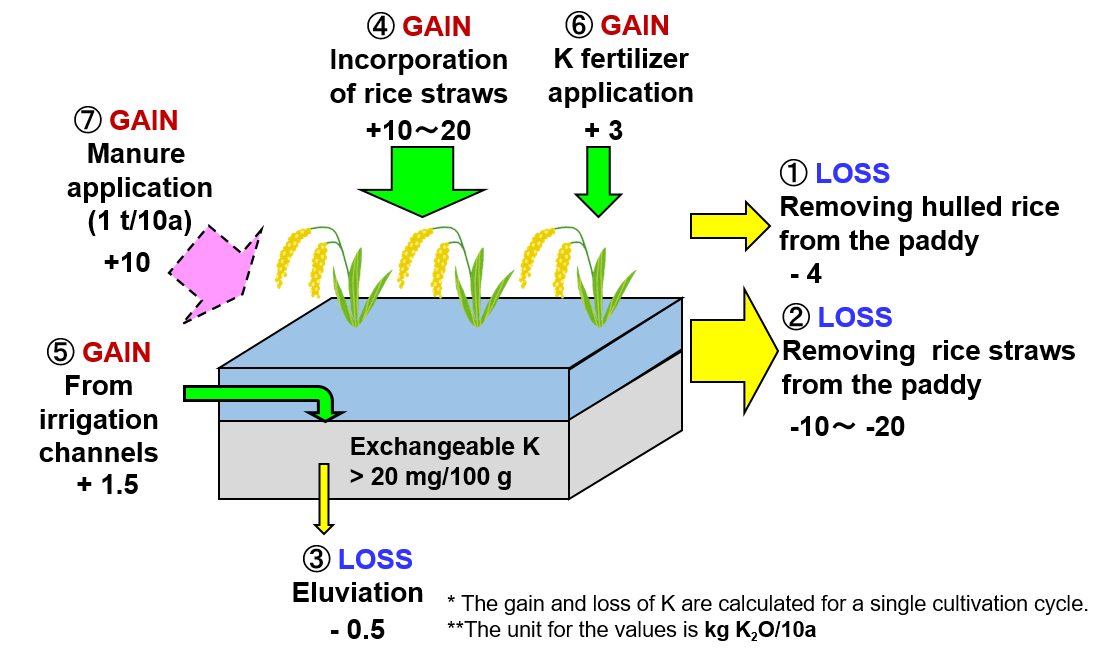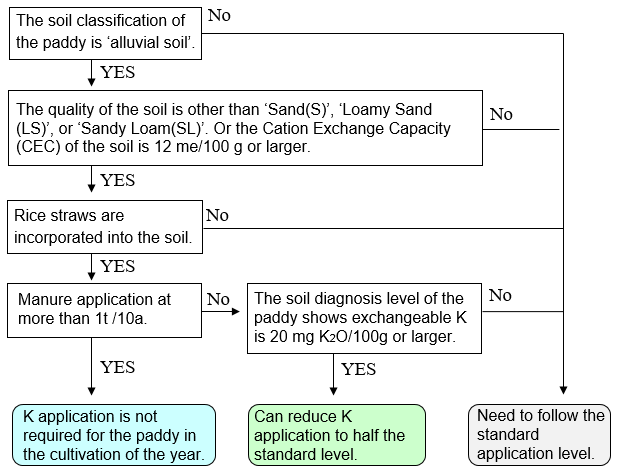The National Agriculture and Food Research Organization (NARO) elucidated the condition for reducing the potassium (K) fertilizer application in paddy fields into half of the standard level or even down to zero while maintaining yield and available K amount in the soil. The instructions are organized as a guideline and have been published online on the NARO website. The guideline applies to paddy fields throughout the country and will contribute to saving the production cost in rice paddy crop farming.
Overview
NARO has published a guideline for reducing potassium (K) fertilizer application in paddy fields on 14 January 2021. The main focus of the guideline is that the farmers can reduce the K fertilizer application to half the standard level or even down to zero in the paddies that match a certain condition. By following the instruction and reducing K input to 3 kg per 10 a, farmers will save their fertilizer cost by 1,056 JPY per 10 a.
K is one of the three major components of fertilizers for plants, and it is essential for agricultural production. However, Japan fully depends on imported K. Considering the constant high price of K in the world market, reducing K usage in rice production is essential for the stable supply of food. In rice paddy crop farming, the standard application level of K is 8 - 10 kg per 10a. But some reports say that rice grows well with less K application than the standard or without any application. The demand for an official guideline on how to reduce K input appropriately in paddies has been high.
In the project supported by MAFF, NARO, in cooperation with several Prefectures (Yamagata, Niigata, Mie, Miyazaki, and Kagoshima), had investigated the effect of reducing K fertilizer application on the growth of rice, and the cycle of K movement (gain and loss of K within the paddy). If the rice straws in the paddies are incorporated into the soil properly, and the amount of exchangeable K is at a certain level, the yield does not decrease and the available K in the soil does not extinguish even with applying half the amount of the K fertilizer as the standard level. Moreover, the paddies described above do not require any K application if cow manure has been applied at the rate of more than 1 t/ 10 a in the same year. The guideline is for the paddies throughout the country and is expected to contribute to saving costs in rice production and the stable supply of food.
For Inquiries
Contact: http://www.naro.affrc.go.jp/english/inquiry/index.html
Reference Information

Fig.1 Understanding the gain and loss cycle of potassium in a paddy field
The gain and loss of potassium(K) within the paddy (① to ⑥) will ultimately add up to zero (①+②+③=④+⑤+⑥)given that the rice straws are incorporated into the soil, and K fertilizer is applied at the half amount of the standard rate (3 kg per 10 a). Additional manure application at the rate of 1 t per 10a will result in the sum of gain and loss as +10 (more than 10 kg per 10 a).

Fig.2 Flow chart for evaluating the possibility of reducing potassium application to a paddy field
Farmers can look up the soil classification of the paddy using the Digital Soil Map developed by NARO. The quality of the soil (fineness of the particles) can be judged by hands. The value of exchangeable K in the soil can be obtained through the soil diagnosis. However, paddies that need regular K application to prevent radioactive cesium accumulation are not covered by the guideline.




